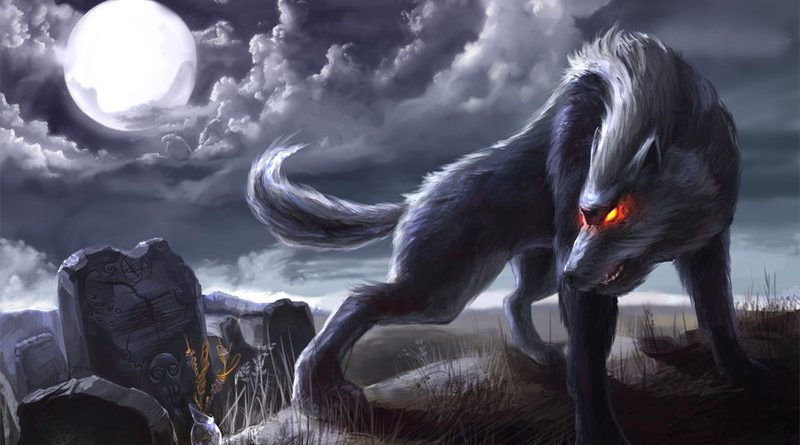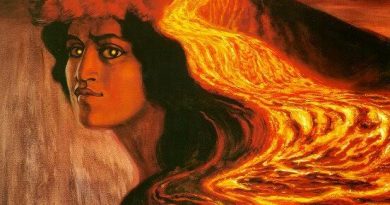Unexplained Mysteries – Phantom Black Dogs
Stories of mysterious phantom black dogs abound in Britain, almost every county has its own variant, from the Black Shuck of East Anglia to the Padfoot and Bogey Beast of Yorkshire. Phantom black dogs have been witnessed too frequently in modern times to parcel the phenomena as pure folklore and legend, but then folklore and legend often has origins in real events. There are various theories to explain the phenomena and they seem to have many common traits from sighting to sighting.
A black dog is a motif of a spectral or demonic entity found primarily in the folklore of the British Isles. The black dog is essentially a nocturnal apparition, in some cases a shapeshifter, and is often said to be associated with the Devil or described as a ghost or hellhound. Its appearance was regarded as a portent of death. It is generally supposed to be larger than a normal dog and often has large glowing eyes. It is sometimes associated with electrical storms (such as Black Shuck’s appearance at Bungay, Suffolk) and also with crossroads, places of execution and ancient pathways.
The origins of the black dog are difficult to discern. It is uncertain whether the creature originated in the Celtic or Germanic elements of British culture. Throughout European mythology, dogs have been associated with death. Examples of this are the Cŵn Annwn (Welsh), Garmr (Norse) and Cerberus (Greek), all of whom were in some way guardians of the Underworld. This association seems to be due to the scavenging habits of dogs. It is possible that the black dog is a survival of these beliefs.
Black dogs are generally regarded as sinister or malevolent, and a few (such as the Barghest and Shuck) are said to be directly harmful. They may also serve as familiar spirits for witches and warlocks. Some black dogs, however, such as the Gurt Dog in Somerset and the Black Dog of the Hanging Hills in Connecticut, are said to behave benevolently. Some, known as guardian black dogs, guide travellers at night onto the right path or guard them from danger
In appearance the phantoms vary from region to region, but it is not uncommon for them to be described as calf sized, with saucer eyes and a shaggy coat. Phantom dogs are not always black however, the one that is supposed to haunt the area around Cawthorpe and Haugham in Lincolnshire, is described as white, but still has saucer eyes and is as big as calf. The Cu Sith, the traditional fairy dog of Scotland is dark green in colour, with a shaggy tail up its back. Black dogs are more often than not associated with a specific location such as an old trackway or lane, this is sometimes reflected in the name of the routeway, although not every ‘Black Dog Lane’ has a tradition of the haunting.
There have been some attempts at classification; the folklorist Theo Brown divided the black dog phenomena into three separate types A, B and C. (A) Being a shape-shifting demon dog; (B) being a dark black dog calf sized with shaggy fur; and (C) a dog that appears in time with certain ancient festivals in specific areas of the country. Katherine Briggs, the renowned folklorist, splits these further into mysterious demon dogs, the ghosts of human beings and the ghosts of dogs in their own right.
In local traditions the black dogs sightings are seen as death portents, especially those seen in ancient churchyards in the form of the Church or Kirk Grim (Kirk being the Scottish word for Church), which is thought to represent a folk memory of a sacrifice. The black dog that used to haunt Peel castle and a nearby graveyard on the Isle of Man, is one such grim, it is said to have scared a sentry to death. Other sightings from the South of England, have been related to coincidental sudden deaths. The next two accounts relate to actual deaths by a black dog over four hundred years ago, although it is likely both events were the result of ball lightning:
A weather vane in Bungay Market in Suffolk depicts a black dog and a flash of lighting, it commemorates an event on Sunday the 4th of August 1577. Between nine and ten in the morning while the parishioners of Bungay were at church, a fearful and violent storm broke out, which caused the sky to darken and the church to quake. Suddenly, in the midst of the storm, a black dog appeared within church. Lit by flashes of fire, it ran about the body of the church causing great fear and panic. It passed between two people kneeling at prayer, killing them instantly, and caused another man to shrivel up, severely burned, although he is said to have survived.
About seven miles away in Blythburgh, at around the same time, another black dog (or the same phenomena) appeared in the parish church preceded by the same thunderstorm. This black dog struck three people dead and left scorch marks on the North church door, which can still be seen today.
These two examples suggest phenomena related to the weather conditions, perhaps some form of little understood ball lighting, substantiated by the fact that one person was burned, and the scorch marks on the church door. It is difficult to make any snap judgements because of the long span of time involved from the recorded events.
Other phantom dogs are more benevolent and stories exist of people being helped from tight spots. For example Augustus Hare in his book ‘In My Solitary Life’ recounts a common tale he heard about a man called Johnnie Greenwood, of Swancliffe. Johnnie had to ride through a wood in darkness for a mile to get to where he was going. At the entrance of the wood he was joined by a black dog, it pattered beside him until he emerged from the trees, whereupon it disappeared as quickly as it had arrived.
On his return journey through the wood, the dog joined him again on the dark woodland path, and disappeared mysteriously when he emerged. Apparently, some years later, two prisoners condemned to death confessed that they had decided to rob and murder Johnny that night in the wood, but the presence of the large black dog had stopped them.
Black dogs often seem to haunt ancient lanes, trackways, crossroads, old churchyards and prehistoric sites. Many of these places were associated with local superstitions and the uncanny, they are liminal places, where the veil between worlds was thought to be thin. The haunts of the black dogs are also features said to denote ley lines, it has been suggested that they represent some form of energy or natural phenomena moulded by the mind into an archetype of the black dog. A great deal of work has been done by earth mystery researchers to suggest that certain geophysical conditions may affect the human mind. These places were recognised by ancient man, and that is why black dogs (as some form of archetype) appear at places of ancient sanctity. This same theory has been applied to other unexplained phenomena.
Gallows sites (often crossroads) were also common black dog haunts, the black dog was often seen as the spirit of the executed criminal, such as the dog said to haunt a gallows site in Tring, Hertfordshire: An old woman was drowned for witchcraft at Tring in the year 1751. A chimney sweep was held responsible in part for the killing, and was hanged and gibbeted near to the place of the crime. A black dog came to haunt the place where the gibbet stood, and was seen by the village schoolmaster. He described it as being shaggy, as big as a Newfoundland, with long ears and a tail, eyes of flaming fire and long teeth. It is interesting to note that at first the black dog appeared as a standing flame. Flames and scorched earth being another aspect associated with sightings.
Black dogs are also seen as guardians of treasure, especially in Scotland. A black dog was said to guard treasure buried under a standing stone near Murthley in Perthshire, here we have an account of a black dog at an ancient site and as a guardian of treasure.
In summery it seems that the phenomena of phantom dogs is a complex mix of folklore, sightings, and local superstition, which has roots reaching far into the past. There are probably a myriad of different explanations for modern sightings, and a phantom black dog is a powerful archetype, incorporated into modern stories such as the ‘Hound of the Baskervilles‘ by Arthur Conan Doyle. We hope to delve into the mystery further in the future, including some of the many folk tales associated with them.
Sightings

- In Thornton, near Bradford, Jim Craven Well was the haunt of the ghost of ‘Peggy wi’t Lantern’ and ‘Bloody Tongue’, a great dog with red eyes and a huge tail. The well is now gone. Meon Hill has both a phantom black dog and a ghostly pack of white hounds. The death of George Walton in very curious circumstances on 14th February 1945 was accompanied by a black dog being hung in a nearby tree. Walton had seen a black dog on nine occasions – the last time it changed into a headless black woman. His sister died shortly after. Although strongly contested, Walton’s death has many overtones of the ritual sacrifice of a ‘cunning man’. During the Second World War at Brook House, Snitterfield (which used to be the Bell Brook Inn) a big black dog was seen. It ran over the tilled earth of the garden without leaving footprints.
- Very old people of Warwick used to say that the castle was haunted by a black dog. The tale has the hallmarks of a time-encrusted tall story. The local version claims it all started when an old retainer there, a woman called Moll Bloxham, sold milk and butter from the castle stores for her personal gain. One Christmas she overdid this, and the then Earl of Warwick, getting wind of it, stopped her source of supply. Furiously angry, she vowed she would ‘get them haunted’. She apparently succeeded and returned in the form of a big black dog. In due course the clergy were called in to exorcise the ghost with bell, book and candle, but for a time they were entirely unsuccessful. Then one day, so it was said, a huge black dog sprang from Caesar’s Tower into the river below, and so ended the ghost story. At Alveston, Charles Walton, a ploughboy, met a phantom black dog on his way home on nine successive evenings. On the final occasion a headless lady in a silk gown rushed past him, and the following day he heard of his sister’s death.
- A black dog has been said to haunt the Newgate Prison for over 400 years, appearing before executions. According to legend, in 1596, a scholar was sent to the prison for witchcraft, but was killed and eaten by starving prisoners before he was given a trial. The dog was said to appear soon after, and although the terrified men killed their guards and escaped, the beast is said to have haunted them wherever they fled. A black dog is said to haunt Ivelet Bridge near Ivelet in Swaledale, Yorkshire. The dog is allegedly headless, and leaps over the side of the bridge and into the water, although it can be heard barking at night. It is considered a death omen, and reports claim that anybody who has seen it died within a year. The last sighting was around a hundred years ago.
- On Dartmoor, the notorious squire Cabell was said to have been a huntsman who sold his soul to the Devil. When he died in 1677, black hounds are said to have appeared around his burial chamber. The ghostly huntsman is said to ride with black dogs; this tale inspired Arthur Conan Doyle to write his well-known story The Hound of the Baskervilles.
- The Cù Sìth (Scottish Gaelic pronunciation: kuː ʃiː) is an enormous, otherworldly hound, said to haunt the Scottish Highlands. Roughly the size of a cow or large calf, the Cù Sìth was feared as a harbinger of death and would appear to bear away the soul of a person to the afterlife (similar to the manner of the Grim Reaper). Supernatural dogs in the legends are usually completely black, or white with red ears. The Cù Sìth’s coloration is therefore highly unusual because of its light green color, although it may be derived from the green color often worn by Celtic fairies.
Some names in different counties:
Bogey Beast, Lancashire
Bargheust, Yorkshire and the North
Black Shuck, East Anglia
Capelthwaite, Westmorland (Cumbria)
Cu Sith, Highlands (Dark Green)
Gallytrot, Suffolk
Guytrash
Gurt Dog, Somerset
Hairy Jack, Lincolnshire
Mauthe Dog, (Mauthe Doog) Scotland
Old Shock or Shuck (Black Shuck), Suffolk
Padfoot, Yorkshire
Pooka, Ireland
Skriker, Lancashire, Yorkshire



